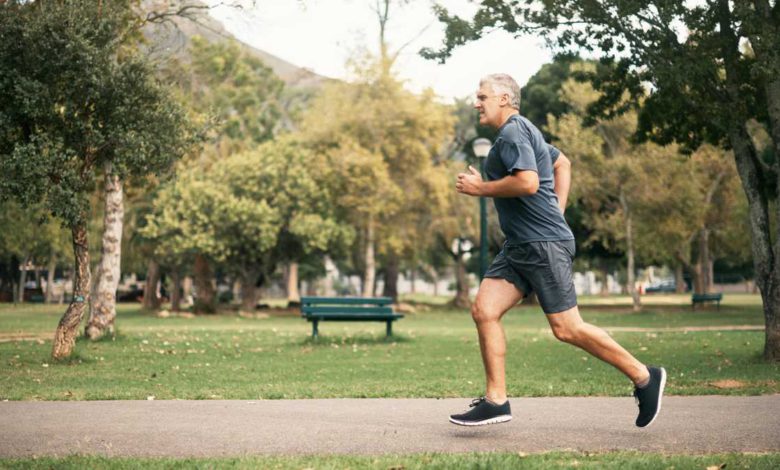

Personal goals are important and achieving even small goals can be good for you. According to a study of 2000 Americans, 76% that self identified as a caregiver, conducted by one poll on behalf of Walgreens found that 74% in an emotional or mental boost when they achieve a small goal. 60% worried that their personal wellness is at odds with their financial wellness Boosting productivity can be simple, 60% said clean up and organizing, 53% paying the bills and 50% doing laundry When it comes to the type of goals that people can complete, 42% said wellness goals are harder to achieve than financial ones. Walgreens study also found that 57% of respondents put financial goals at the front of the list, which makes sense. Not many people love diet and exercise.
Even if you aren't gifted athletically or you hate all things involving exercise, reams of research shows physical activity is critical to good health. "Exercise is key, because your life depends on it," said Howard Rankin, a behavior change researcher and director of science at Intuality, Inc.That's no exaggeration. Establishing a regular workout regimen slashes your risk of heart disease and stroke, Type 2 diabetes, and certain forms of cancer, such as breast, colon and lung, according to the U.S. Centers for Disease Control and Prevention. Exercising also strengthens your bones and muscles, improves sleep, and lessens the pain from arthritis and other joint conditions. And there's more.Regular physical activity is great at combating anxiety and depression, Rankin said, and it's critical for the development of new brain cells. Movement also helps balance brain chemicals like endorphins and dopamine, which are responsible for motivation and feeling energetic, and it's a great stress buster. Consistent exercise even improves your sex life, according to experts at Mayo Clinic.Conversely, ignore exercise and your risk of death soars 20% to 30% compared to those who are active, according to the World Health Organization. Luckily, all you need to do is about 150 minutes of moderate-intensity physical activity — just 21 minutes a day — to enjoy the benefits.Ready to create a workout routine you can stick with and enjoy? Here are four tips you may find beneficial.Important note: Before beginning any new exercise program, consult your doctor. Stop immediately if you experience pain.1. Make exercising a regular part of your dayDecide exercise has to be a regular part of your day, like eating or sleeping — because it's equally important. Once your mindset shifts, your excuses may disappear.You can also schedule your workouts ahead of time if you can't always exercise at the same time every day. Setting a specific time for working out can help you keep on task. If you can't find one big block of time, break up your workout into several shorter segments to complete throughout the day. Experts say this is fine, as you'll reap the same benefits.2. Start slowly, and give your new routine timeDon't do too much, too soon. If you want to try running, don't go out and run 3 miles as fast as you can. Alternate running a block or a minute with walking a block or a minute for just 1 mile and build from there. This same principle applies to any new activity you select.And give your new activity time, as it takes a while for a new behavior to become a habit."I can't tell you how many people give up after a week or two because it feels hard or they aren't seeing results," said Tami Smith, a certified personal trainer and CEO of Fit Healthy Momma. "Give yourself a chance to begin to see and feel the benefits. Commit to at least 30 days of consistency and then evaluate how you're feeling about it."3. Find a form of exercise you like doingNot everyone will get into running. Try a variety of exercises and see what suits you. It might be running, swimming, biking, using an elliptical machine, or a taking a kickboxing class. Or you might prefer working out to a video or dancing in your living room. It's all movement, and that's all good.Remember, too, that many simple activities like walking promote physical fitness. "The term 'exercise' can imply rigorous workouts, but movement doesn't have to be rigorous to be beneficial," Rankin said. "Any movement is better than no movement."The more you enjoy exercising, the more confidence you'll have that you can overcome any barriers to exercise, which means you'll be more likely to stick with your regime, according to a 2015 study by Beth Lewis, director of the University of Minnesota's School of Kinesiology. "The key to maintaining exercise is to find an exercise routine that you enjoy, whether it is alone or with people; outside, at home or at a gym."4. Ramp up the fun factorEven if you find an exercise you enjoy, not every workout will be fun. Sometimes you'll be tired or cranky or just not in the mood to work out. You can also get in a rut, where you don't necessarily dislike your workout, but it doesn't excite you, either. This is when it's time to get creative.Instead of working out at the gym, drive to your favorite park for an al fresco exercise session. Join a friend in their favorite activity. Sign up for a class that's piqued your interest, like aqua yoga or Pilates. Treat yourself to some new workout clothes. Do whatever it takes to stay in motion. Because not only is movement good for us, it's what our bodies are designed to do."We are built to move," said Brett Durney, cofounder of London's Fitness Lab, a private personal training studio. "Those of us who are blessed enough to be able to move freely should reap the benefits daily."
Even if you aren't gifted athletically or you hate all things involving exercise, reams of research shows physical activity is critical to good health.
"Exercise is key, because your life depends on it," said Howard Rankin, a behavior change researcher and director of science at Intuality, Inc.
That's no exaggeration. Establishing a regular workout regimen slashes your risk of heart disease and stroke, Type 2 diabetes, and certain forms of cancer, such as breast, colon and lung, according to the U.S. Centers for Disease Control and Prevention. Exercising also strengthens your bones and muscles, improves sleep, and lessens the pain from arthritis and other joint conditions. And there's more.
Regular physical activity is great at combating anxiety and depression, Rankin said, and it's critical for the development of new brain cells. Movement also helps balance brain chemicals like endorphins and dopamine, which are responsible for motivation and feeling energetic, and it's a great stress buster. Consistent exercise even improves your sex life, according to experts at Mayo Clinic.
Conversely, ignore exercise and your risk of death soars 20% to 30% compared to those who are active, according to the World Health Organization. Luckily, all you need to do is about 150 minutes of moderate-intensity physical activity — just 21 minutes a day — to enjoy the benefits.
Ready to create a workout routine you can stick with and enjoy? Here are four tips you may find beneficial.
Important note: Before beginning any new exercise program, consult your doctor. Stop immediately if you experience pain.
1. Make exercising a regular part of your day
Decide exercise has to be a regular part of your day, like eating or sleeping — because it's equally important. Once your mindset shifts, your excuses may disappear.
You can also schedule your workouts ahead of time if you can't always exercise at the same time every day. Setting a specific time for working out can help you keep on task. If you can't find one big block of time, break up your workout into several shorter segments to complete throughout the day. Experts say this is fine, as you'll reap the same benefits.
2. Start slowly, and give your new routine time
Don't do too much, too soon. If you want to try running, don't go out and run 3 miles as fast as you can. Alternate running a block or a minute with walking a block or a minute for just 1 mile and build from there. This same principle applies to any new activity you select.
And give your new activity time, as it takes a while for a new behavior to become a habit.
"I can't tell you how many people give up after a week or two because it feels hard or they aren't seeing results," said Tami Smith, a certified personal trainer and CEO of Fit Healthy Momma. "Give yourself a chance to begin to see and feel the benefits. Commit to at least 30 days of consistency and then evaluate how you're feeling about it."
3. Find a form of exercise you like doing
Not everyone will get into running. Try a variety of exercises and see what suits you. It might be running, swimming, biking, using an elliptical machine, or a taking a kickboxing class. Or you might prefer working out to a video or dancing in your living room. It's all movement, and that's all good.
Remember, too, that many simple activities like walking promote physical fitness. "The term 'exercise' can imply rigorous workouts, but movement doesn't have to be rigorous to be beneficial," Rankin said. "Any movement is better than no movement."
The more you enjoy exercising, the more confidence you'll have that you can overcome any barriers to exercise, which means you'll be more likely to stick with your regime, according to a 2015 study by Beth Lewis, director of the University of Minnesota's School of Kinesiology. "The key to maintaining exercise is to find an exercise routine that you enjoy, whether it is alone or with people; outside, at home or at a gym."
4. Ramp up the fun factor
Even if you find an exercise you enjoy, not every workout will be fun. Sometimes you'll be tired or cranky or just not in the mood to work out. You can also get in a rut, where you don't necessarily dislike your workout, but it doesn't excite you, either. This is when it's time to get creative.
Instead of working out at the gym, drive to your favorite park for an al fresco exercise session. Join a friend in their favorite activity. Sign up for a class that's piqued your interest, like aqua yoga or Pilates. Treat yourself to some new workout clothes. Do whatever it takes to stay in motion. Because not only is movement good for us, it's what our bodies are designed to do.
"We are built to move," said Brett Durney, cofounder of London's Fitness Lab, a private personal training studio. "Those of us who are blessed enough to be able to move freely should reap the benefits daily."
Source link








